The Pinnacle of The Energy Revolution: Sodium vs. Lithium Batteries
Home – Info Center – Blogs –
The Pinnacle of The Energy Revolution: Sodium vs. Lithium Batteries

By Michael Zhang || Updated on 10th April 2024
Michael Zhang is a seasoned professional with 15 years of experience in the solar lights industry. Throughout his career, he has been actively involved in product design and developing, gaining valuable expertise and insight into the industry. Known for his dedication and professionalism, Michael has contributed significantly to the growth and success of various solar lights projects. His extensive knowledge and hands-on experience make him a trusted authority in the field, and he continues to innovate and excel in his role.
In this article, we take an in-depth look at the intricate differences between these two prominent battery technologies, aiming to shed light and provide insight into their respective strengths and limitations.
From energy density and cycle life to suitability for a variety of applications, we explore the subtle differences between sodium and lithium batteries.
Table of Contents
The Concept Of Sodium And Lithium Batteries
In the field of energy storage, both sodium batteries and lithium batteries play an important role. With the continuous progress of science and technology, these two types of battery technology is also constantly developing, which brings a lot of convenience to our lives. However, what are the differences and similarities between them? Let’s take a look.
What Is A Lithium Battery?
A lithium battery is a type of battery that uses lithium ions as the anode material of the battery. It implements the charge/discharge process by moving lithium ions between the positive and negative electrodes to store and release energy. Li-ion batteries have the advantages of high energy density, light weight, and long cycle life, and are therefore widely used in a variety of applications, including mobile electronic devices, electric vehicles, and energy storage systems.
What Is A Sodium Battery?
Sodium batteries, on the other hand, are similar to lithium batteries, but they use sodium ions instead of lithium ions for energy storage. Sodium batteries work similarly to lithium batteries in that the charging and discharging process is accomplished by the movement of sodium ions between the positive and negative electrodes.
Sodium batteries are often considered to have potential advantages, such as abundant sodium resources, low cost, and better safety, and therefore have attracted much attention in the field of energy storage, especially in large-scale energy storage projects.
What Are The Physicochemical Differences Between Sodium And Lithium?
As can be seen from the figure below, there are differences in the physicochemical properties of sodium and lithium, and as a result, they differ in electrochemical performance.
Sodium ions have a larger mass and radius, and migrate more slowly in sodium storage materials, which is not conducive to the improvement of the multiplication performance of sodium-ion batteries, and also leads to the energy density of sodium-ion batteries being inferior to that of lithium-ion batteries.
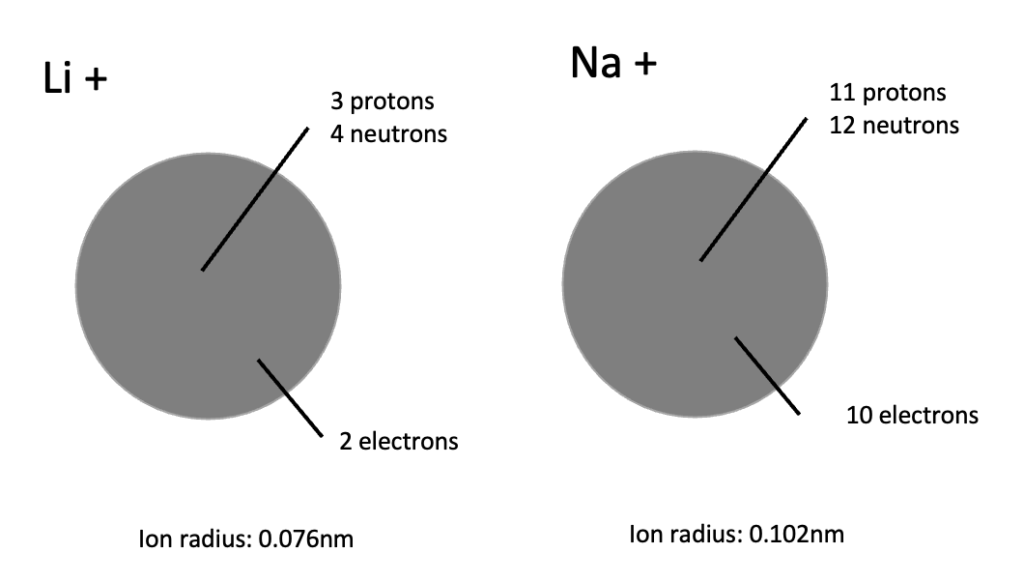
Energy Density
In this section, we will compare the energy density of sodium and lithium batteries to better understand the differences between the two types of batteries.
What is Energy Density?
Before we start comparing the energy density of sodium and lithium batteries, we need to understand what energy density is.
Battery energy density (Energydensity) refers to the average unit volume or mass of the battery released by the electrical energy, the basic unit for Wh/kg (watt hours / kg), for example: I am a battery, I have 100WH of electrical energy, my body weight is 1KG, so my energy density is 100WH/KG.
Battery energy density is divided into two concepts: single cell energy density and battery system energy density, what is the difference between the two?
The cell is the smallest unit of the battery pack, we can regard the cell as a person, assuming that the weight of each person is 50kg, and the amount of electricity in each person is 5000Wh, then his energy density is 5000Wh ÷ 50kg = 100Wh/kg.
Battery system not only includes the battery cell, the entire battery pack also contains battery management system, thermal management system, high and low voltage circuits, etc., these things are occupied by the weight of the battery system, which is equivalent to a group of people in a house.
The house also has air conditioning, water heaters and other home appliances, assuming that the total amount of power of this group of people for 10000Wh, the entire house, including the weight of the people and appliances for the weight of 200kg, then the battery system energy The energy density of the battery system is 10000Wh÷200kg=50Wh/kg.
What Is The Energy Density Of Sodium Batteries?
Similarly, in order to get the approximate range of energy density of lithium batteries, we will also get some data by comparing some well-known companies in lithium batteries:
| Company Name | Energy Density |
|---|---|
| Natron Energy | 100Wh/kg |
| CATL | 160Wh/kg |
| Faradion | 160 Wh/kg |
| Altris | 160Wh/kg |
| NGK Insulators Ltd. | 222 Wh/kg |
What Is The Energy Density Of Lithium Batteries?
Similarly, in order to get the approximate range of energy density of lithium batteries, we will also get some data by comparing some well-known companies in lithium batteries:
The Difference In Energy Density Between Sodium Batteries And Lithium Batteries
In order to facilitate everyone’s better understanding, let’s compare the difference in energy density between CATL’s sodium batteries and lithium batteries.
CATL’s Kirin battery, a type of lithium-ion battery, has an energy density of up to 255Wh/kg, thanks to its advanced materials and structural design.
In contrast, sodium-ion battery technology has not yet reached the maturity level of lithium-ion batteries. Although sodium-ion batteries have the advantages of low cost, high safety and good high and low temperature performance, their energy density is currently relatively low, only about 160Wh/kg.
This is mainly because the physical and chemical properties of sodium ions are different from those of lithium ions, making it difficult for sodium-ion batteries to reach the energy density of lithium-ion batteries under the same conditions.
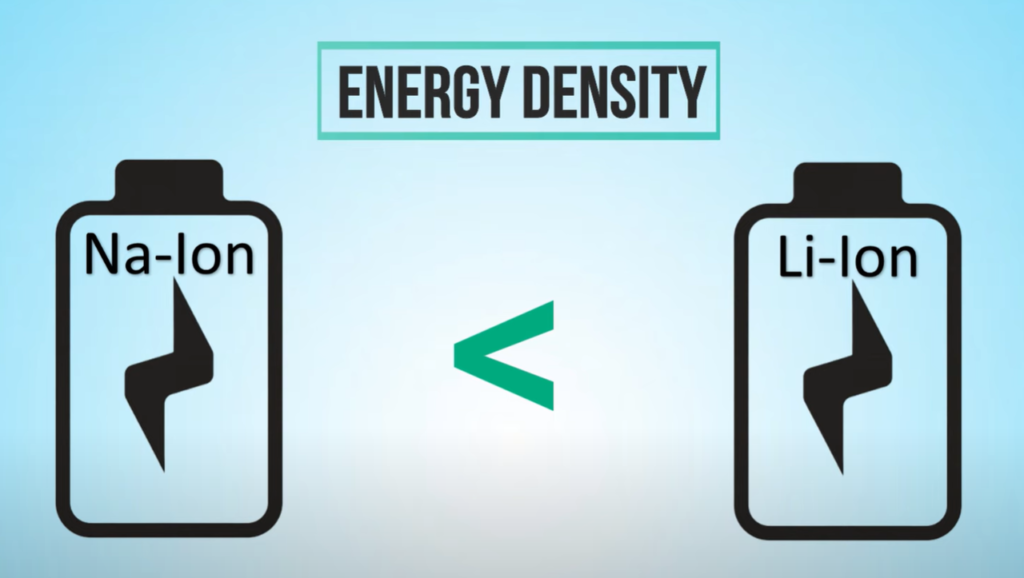
Charge And Discharge Cycle Life
In this section, we will better understand the differences between the two batteries by comparing the difference in charge and discharge cycle life of sodium batteries and lithium batteries.
What Is Charge-Discharge Cycle Life?
“Charge and Discharge Cycle Life” is the number of complete charge and discharge cycles a battery can undergo before its capacity and performance drops to a specified level. In short, it measures the number of times a battery can be charged and discharged before it no longer operates efficiently.
What Is The Charge-Discharge Cycle Life Of Sodium Batteries?
Here are battery cycle times from leading sodium battery manufacturers around the world:
| Company Name | Cycles Times |
|---|---|
| Natron Energy | 25000 |
| CATL | 3000 |
| Faradion | 4000 |
| Altris | / |
| NGK Insulators Ltd. | 7300 |
What Is The Charge-Discharge Cycle Life Of Lithium Batteries?
Here are battery cycle times from leading Lithium battery manufacturers around the world:
Differences In Charge And Discharge Cycle Life Between Sodium Batteries And Lithium Batteries
It can be seen that the charge and discharge cycle life of sodium batteries is much longer than that of lithium batteries. Therefore, the high cycle life of sodium batteries provides a more stable, reliable and economical solution for sustainable energy and power systems, helping to To promote the development and application of clean energy technologies.
Charging Speed
The diffusion coefficient of sodium ions in the liquid electrolyte is about 10 times smaller than that of lithium ions, so the migration speed of sodium ions in the electrolyte is much slower than that of lithium ions, causing the charge and discharge rate of sodium-ion batteries to be limited.
Therefore, lithium batteries charge faster and have higher energy conversion efficiency. This gives lithium batteries an advantage in scenarios that require fast charging and efficient energy conversion.
Usage Efficiency
One of the biggest drawbacks of lithium batteries is their abnormal power loss in extreme temperatures. Due to various factors such as the car owner’s driving habits, the temperature of the external environment, and the driving road conditions, the battery life of lithium batteries often shrinks to varying degrees.
Especially in the cold winter, when the temperature drops below zero, the battery life of ternary lithium batteries will generally drop by about 25%, and lithium iron phosphate batteries will shrink by about 30%. This undoubtedly brings a lot of trouble to car owners, and also limits the application of lithium batteries in a wider range of scenarios.
In contrast, sodium-ion batteries have shown better adaptability to high and low temperature environments. According to experimental results from the Institute of Physics of the Chinese Academy of Sciences, in a hot environment of up to 80°C, the power retention rate of a sodium-ion battery can still be maintained at about 80% after 900 cycles of charge and discharge.
What’s even more surprising is that even in extremely low temperature environments of minus 20°C, sodium batteries can maintain more than 90% of their power and are almost unaffected by low temperatures. This characteristic makes sodium-ion batteries very promising for use in extreme climate conditions.
To sum up, although lithium batteries perform well in many aspects, their sensitivity to extreme temperatures is an issue that cannot be ignored. Sodium-ion batteries, with their excellent high and low temperature adaptability, provide new possibilities for the development of energy storage technology.
Security
In terms of safety, the performance of sodium-ion batteries is indeed impressive. According to testing by the authoritative China Automotive Technology and Research Center Co., Ltd. (CATARC), sodium-ion batteries have shown extremely high safety in acupuncture experiments. Not only do they not smoke, fire, or explode, but they also survive short circuits and overheating.
Under extreme experimental conditions such as charging, over-discharging, and extrusion, it always maintains a stable state of combustion without fire. In contrast, lithium-ion batteries performed poorly in these tests, showing that sodium-ion batteries have a significant safety advantage.
In addition, sodium-ion batteries also have better thermal stability. The initial self-heating temperature of lithium-ion batteries is 165°C, while that of sodium-ion batteries is as high as 260°C. This means that at higher temperatures, sodium-ion batteries can still remain stable and are less prone to safety issues such as thermal runaway. In the ARC test, the maximum self-heating rate of sodium-ion batteries was also significantly lower than that of lithium-ion batteries, further demonstrating their excellent thermal stability.
It is worth mentioning that in all current safety project tests, sodium-ion batteries have not caught fire, which fully illustrates its excellent safety performance. This characteristic makes sodium-ion batteries have broader application prospects in high-risk fields such as electric vehicles and energy storage power stations, and can provide safer and more reliable energy security for people’s daily lives and industrial production.
To sum up, sodium-ion batteries have excellent performance in terms of safety. They not only have extremely high thermal stability, but also maintain stable operation under various extreme conditions. With the continuous advancement of technology and the gradual reduction of costs, it is believed that sodium-ion batteries will be more widely used and promoted in the future.
Cost
The average price of lithium carbonate in 2022 will be around 400,000 yuan/ton, and the selling price of lithium iron phosphate batteries will be as high as 0.8 yuan/WH. Now as the price of lithium carbonate falls, the prices of other materials in the industry chain have also fallen sharply. Now power iron phosphate The price of lithium battery cells has fallen below 0.5 yuan/WH, with the latest price being 0.47 yuan/WH, while the current price of sodium battery cells is about 0.67 yuan/WH. In such a comparison, the cost-effective advantage of sodium ions has disappeared.
Performance Summary
We will make a comprehensive comparison from the energy density, charge and discharge cycle life, charging speed, usage efficiency, and cost of sodium batteries:
| Feature | Sodium-ion battery | Lithium-ion battery |
|---|---|---|
| Energy Density | Lower | Higher |
| Cycle Times | Higher | Lower |
| Charging Speed | Lower | Higher |
| Usage Efficiency | Higher | Lower |
| Safety | Higher | Lower |
| Cost | Lower | Higher |
Application Field Comparison
After the above analysis and comparison, we know that for the future development of sodium batteries and lithium batteries, will be further towards their respective areas of strength.
Mobile Electronic Devices
For mobile electronic devices, such as smartphones, tablets and laptops, lithium batteries are undoubtedly a more suitable choice at present.
Lithium batteries are like small energy treasures. They have high energy density, which means they can store more energy and allow our mobile devices to last longer. Moreover, it charges very quickly. Once the battery is low, it can quickly regain its vitality and continue to accompany us in work, entertainment and study.
What’s more worth mentioning is that lithium batteries are lightweight and very suitable for the thin and light design requirements of modern mobile devices. It can provide sufficient battery capacity without increasing the weight of the device, allowing us to enjoy a convenient mobile life without having to worry about power issues.
Of course, sodium batteries also have unique advantages in some aspects, such as longer cycle life and relatively abundant sodium resources. But at present, the energy density and charging speed of sodium batteries are not comparable to that of lithium batteries, especially in mobile devices that require higher energy density and charging speed.
In general, lithium batteries are still the most suitable choice for current mobile electronic devices. But we also expect that sodium batteries can bring more surprises and breakthroughs in the future, making our mobile life more colorful.
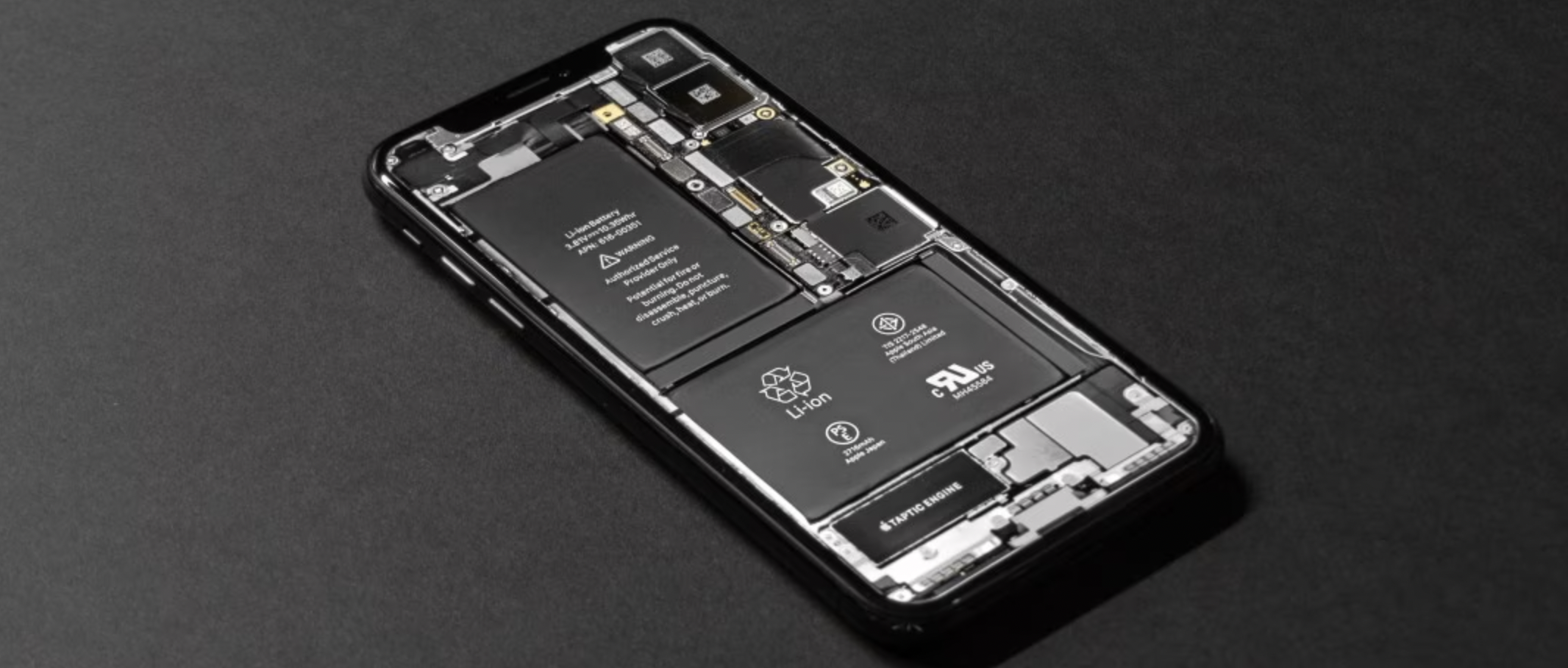
Electric Vehicles
At present, lithium batteries seem to be a powerful assistant for electric vehicles. They are like small energy warehouses with high energy density, fast charging speed, and light body. Such characteristics make lithium batteries shine in the electric vehicle industry and become one of the mainstream energy solutions.
Imagine driving an electric car on a long journey. The lithium battery can provide you with enough energy to make your car ride easily. Moreover, you don’t have to worry when the power is low, because the lithium battery can be fully charged in a short time, greatly shortening the charging time and possible battery life problems.
What’s more worth mentioning is that the lightweight design of lithium batteries makes electric vehicles lighter, which not only improves energy efficiency but also increases driving range. Such advantages make electric vehicles more outstanding in performance and win the favor of consumers.
Of course, sodium batteries also have their advantages, such as longer cycle life and abundant sodium resources. But at present, its energy density and charging speed are relatively weak, and may not be suitable for electric vehicles, especially those pursuing high energy density and fast charging.
However, we cannot underestimate the development potential of sodium batteries. As technology continues to advance, sodium batteries are likely to become more powerful in the future, providing more options for electric vehicles and pushing the entire industry to new heights.
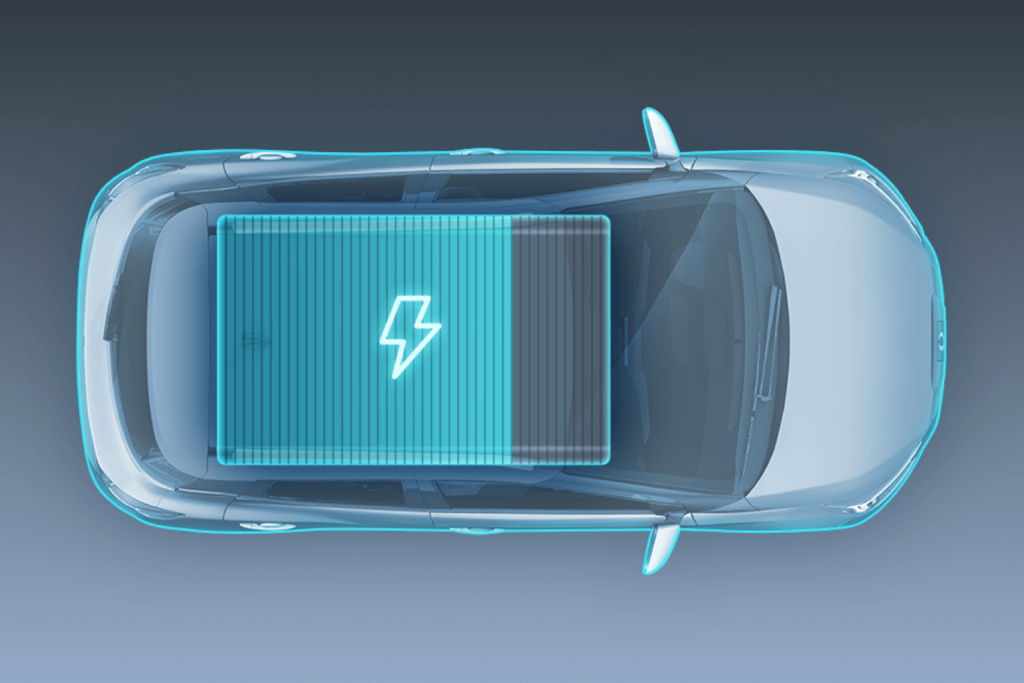
Energy Storage Systems
In the field of energy storage system exploration, sodium batteries and lithium batteries each have unique advantages. Which battery to choose depends on specific application requirements and environmental conditions.
Sodium batteries may be useful in certain applications, such as large energy storage systems or scenarios that require long-duration operation. This is because sodium, a resource that is relatively cheap and abundant, gives sodium batteries a considerable cost advantage. What’s more, sodium batteries have a longer cycle life, making them a more attractive option for applications that require a long-term stable energy supply.
However, when we talk about applications that require high energy density, fast charging, and lightweight design, lithium batteries excel. The high energy density of lithium batteries means that more energy can be stored in a limited space, which is crucial for applications with large energy requirements. At the same time, the charging speed of lithium batteries is also relatively fast, which makes it more advantageous in scenarios that require quick response to energy needs, such as grid regulation or the rapid charging needs of electric vehicles.
Therefore, when choosing between sodium and lithium batteries, we need to consider the specific needs of the application, cost-effectiveness, and environmental conditions. Each type of battery has its own unique advantages, and only when placed in the most suitable application scenario can they achieve maximum performance.
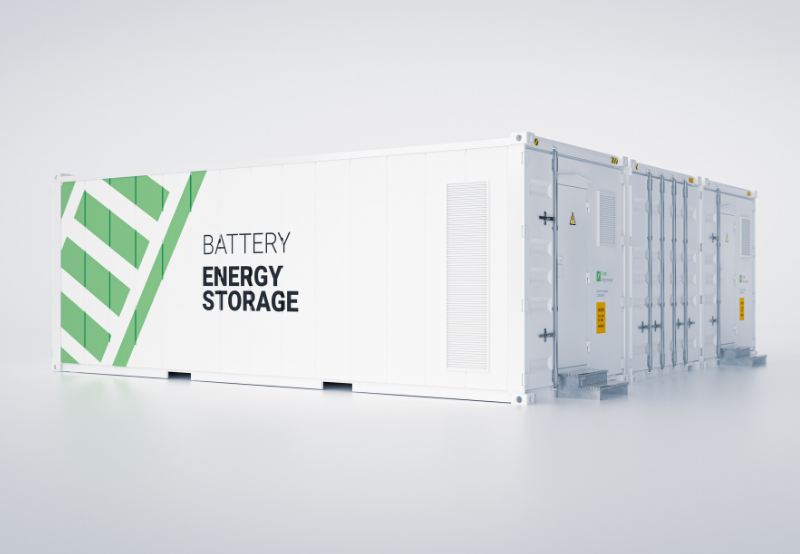
Environmental and Sustainability Considerations
Beyond that, we can revisit the differences from a cost and sustainability perspective.
Resource Availability And Environmental Impact
Sodium and lithium are both elements in the Earth’s crust, and their concentrations on Earth vary significantly.
Sodium is quite abundant in the earth’s crust, reaching about 2.4% to 2.8%, making it the sixth most abundant element in the earth’s crust. It exists mainly in the earth’s crust in the form of table salt and mineral salts, and is widely and evenly distributed. In addition, the content of sodium in seawater is also quite abundant, which can be said to be inexhaustible.
In contrast, lithium content is relatively small. The content of lithium in the earth’s crust is approximately 0.0065%, ranking 27th in abundance. Although there are more than 150 known minerals containing lithium, global reserves of lithium are still relatively limited, approximately less than 70 million tons. Although seawater contains lithium, the concentration is too small and it is difficult to extract.
To sum up, the content of sodium on the earth is much higher than the content of lithium, and the abundance of sodium resources is much greater than that of lithium. This difference also affects their application and status in economic and technological development.
Sustainability Of Production And Recycling Processes
The production and recycling processes for sodium batteries are relatively simple, whereas those for lithium batteries involve more complex processes and equipment.
Sodium production relies heavily on the electrolysis of seawater method. In this process, the seawater first needs to be filtered out of impurities to make it pure seawater. Next, the charge between the pure seawater and the electrolyte is balanced by means of pretreatment, such as calcification and carbonization, so that the electrolysis reaction can take place. In the electrolyzer, sodium and chloride ions are produced from the pretreated seawater, and the sodium metal formed is subsequently collected while the chlorine gas is discharged.
The lithium production recycling process, on the other hand, is relatively complex. Waste power batteries are first separated by means of crushing, sieving and magnetic separation to obtain valuable products. For ternary batteries, the electrode material is roasted with limestone in a high-temperature environment, and then separated to extract copper, nickel, cobalt, manganese and other alloying elements. Recycling of lithium iron phosphate batteries, on the other hand, requires the use of specific fire or wet processes to remove the organic binder and separate out the lithium iron phosphate material.
In terms of recycling, sodium scrap is recovered by heating it to melt in an inert solvent to detach it from the “oxide skin”, thus recovering the sodium metal. The recycling of lithium batteries includes steps such as cleaning and separating the batteries, crushing the lithium batteries, manual disassembly, and separating and recycling the individual materials.
In summary, the production of sodium relies heavily on the electrolysis process, while the production and recovery of lithium involves battery treatment and complex chemical separation techniques. In addition, the recovery of sodium is relatively simple and straightforward, while the recovery of lithium is more complex and requires different processes for different types of batteries. These differences reflect the different chemical properties and applications of sodium and lithium, and influence their different strategies in industrial production and recycling.
Conclusion
To summarize, there are differences between sodium batteries and lithium batteries in terms of performance, cost and market prospect. Lithium batteries with its high energy density, long cycle life and fast charging ability in electric vehicles and other fields occupy an advantageous position; while sodium batteries have potential application prospects in large-scale energy storage and other fields due to its low cost and environmental advantages. In the future, with the continuous progress of technology and changes in market demand, these two battery technologies will continue to develop and compete with each other to jointly promote the progress of the energy storage field.
FAQs
The cost of ternary lithium battery of Ningde Times is about 0.8 Yuan/Wh, while the price of sodium battery cell is about 0.67 Yuan/WH, therefore, from the current point of view, sodium battery does not have a significant cost advantage over ternary lithium battery.
Currently sodium batteries can not replace lithium batteries, due to the physical and chemical differences between sodium and lithium, the two are more likely to play a complementary role in the market later, sodium batteries due to its abundant resources and production and recycling of simple advantages and shortcomings of low energy density, will be used in large-scale energy storage equipment, lithium batteries to maintain their own advantages in the small household appliances continue to make an impact.
Yes, sodium batteries as a cleaner and sustainable energy source will be the future direction of development, with the improvement of energy density of sodium batteries and the decline of manufacturing costs, will soon be on the road to commercialization.
Sodium batteries are safer than lithium batteries. Firstly, sodium batteries are chemically stable and are not easy to burn on their own, and secondly, sodium batteries are relatively safe in the event of a short circuit and other abnormalities, because the resistance of sodium-ion batteries is higher than lithium-ion batteries, and the current is more limited in the event of a short-circuit, which lowers the risk of fire or explosion.
Many battery manufacturers are now developing and producing sodium batteries, but they are not yet fully popularized. Currently, sodium batteries are sold by Ningde Times, Natron Energy, etc. In April 2023, sodium batteries from Ningde Times will be used in Chery cars under the brand name "ENER-Q".
Related Blogs
Share Via:
Get in Touch with Us Now!
Got questions or feedback? We’d love to hear from you! Just fill out the form below, and our friendly team will respond ASAP.
